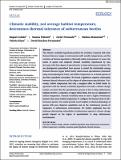Por favor, use este identificador para citar o enlazar a este item:
http://hdl.handle.net/10261/266523COMPARTIR / EXPORTAR:
 SHARE SHARE
 CORE
BASE CORE
BASE
|
|
| Visualizar otros formatos: MARC | Dublin Core | RDF | ORE | MODS | METS | DIDL | DATACITE | |

| Título: | Climatic stability, not average habitat temperature,determines thermal tolerance of subterranean beetles |
Autor: | Colado, Raquel; Pallarés, Susana CSIC ORCID; Fresneda, Javier; Mammola, Stefano; Rizzo, Valeria CSIC; Sánchez-Fernández, David CSIC ORCID | Palabras clave: | Cave fauna Climate change Climatic variability hypothesis Deep subterranean environment Habitat temperature Leiodidae Mountain passes hypothesis Thermal tolerance |
Fecha de publicación: | abr-2022 | Editor: | Ecological Society of America | Citación: | Ecology - Ecological Society of America 103(4): e3629 (2022) | Resumen: | The climatic variability hypothesis predicts the evolution of species with widethermal tolerance ranges in environments with variable temperatures, and theevolution of thermal specialists in thermally stable environments. In caves, theextent of spatial and temporal thermal variability experienced by taxadecreases with their degree of specialization to deep subterranean habitats. Weuse phylogenetic generalized least squares to model the relationship amongthermal tolerance (upper lethal limits), subterranean specialization (estimatedusing ecomorphological traits), and habitat temperature in 16 beetle species ofthe tribe Leptodirini (Leiodidae). We found a significant, negative relationshipbetween thermal tolerance and the degree of subterranean specialization. Con-versely, habitat temperature had only a marginal effect on lethal limits. Inagreement with the climatic variability hypothesis and under a climate changecontext, we show that the specialization process to live in deep subterraneanhabitats involves a reduction of upper lethal limits, but not an adjustment tohabitat temperature. Thermal variability seems to exert a higher evolutionarypressure than mean habitat temperature to configure the thermal niche of sub-terranean species. Our results provide novel insights on thermal physiology ofspecies with poor dispersal capabilities and on the evolutionary process ofadaptation to subterranean environments. We further emphasize that thepathways determining vulnerability of subterranean species to climate changegreatly depend on the degree of specialization to deep subterraneanenvironments. | Versión del editor: | https://doi.org/10.1002/ecy.3629 | URI: | http://hdl.handle.net/10261/266523 | DOI: | 10.1002/ecy.3629 | ISSN: | 0012-9658 |
| Aparece en las colecciones: | (MNCN) Artículos (IBE) Artículos |
Ficheros en este ítem:
| Fichero | Descripción | Tamaño | Formato | |
|---|---|---|---|---|
| Climatic_stability.pdf | 373,23 kB | Adobe PDF |  Visualizar/Abrir |
CORE Recommender
SCOPUSTM
Citations
11
checked on 31-mar-2024
WEB OF SCIENCETM
Citations
7
checked on 27-feb-2024
Page view(s)
60
checked on 23-abr-2024
Download(s)
124
checked on 23-abr-2024
Google ScholarTM
Check
Altmetric
Altmetric
NOTA: Los ítems de Digital.CSIC están protegidos por copyright, con todos los derechos reservados, a menos que se indique lo contrario.


